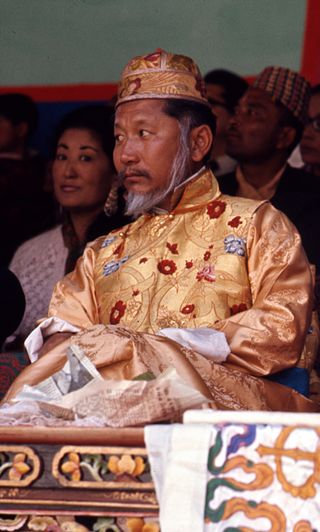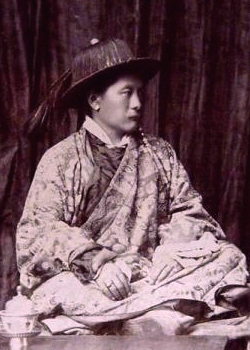
Palden Thondup Namgyal was the 12th and last Chogyal (king) of the Kingdom of Sikkim.

Hope Cooke was the Gyalmo of the 12th and last Chogyal (King) of Sikkim, Palden Thondup Namgyal. Their wedding took place in March 1963. She was termed Her Highness The Crown Princess of Sikkim and became the Gyalmo of Sikkim at Palden Thondup Namgyal's coronation in 1965. She is the first American-born Queen Consort.
Namgyal, a Tibetan deity, has been a personal name in several countries; see :

The Chogyal were the monarchs of the former Kingdom of Sikkim, which belonged to the Namgyal dynasty. The Chogyal was the absolute monarch of Sikkim from 1642 to 1973, and the constitutional monarch from 1973 to 1975, when the monarchy was abolished and the Sikkimese people voted in a referendum to make Sikkim the 22nd state of India.

The history of Sikkim begins with the indigenous Lepcha's contact with early Tibetan settlers. Historically, Sikkim was a sovereign Monarchical State in the eastern Himalayas. Later a protectorate of India followed by a merger with India and official recognition as a state of India. Lepchas were the main inhabitants as well as the Rulers of the land up to 1641. Lepchas are generally considered to be the first people, Indigenous to Sikkim also includes Darjeeling.

Rabdentse was the second capital of the former Kingdom of Sikkim from 1670 to 1814. The capital city was destroyed by the invading Gurkha army and only the ruins of the palace and the chortens are seen here now. However, the ruins of this city are seen close to Pelling and in West Sikkim district in the Northeastern Indian state of present-day Sikkim; Pemayangtse Monastery is one of the oldest monasteries in Sikkim which is close to the ruins. From the vantage point of this former capital, superb views of the Khanchendzonga ranges can be witnessed. This monument has been declared as of national importance by the Archaeological Survey of India. It was first established in 1670 by the 2nd Chogyal Tensung Namgyal son of the 1st Chogyal Phuntsog Namgyal by shifting from the first capital of Yuksom that was consecrated in 1642.

Tashi Namgyal Academy (TNA) is a public school in the Himalayan state of Sikkim in India. It was founded in 1926 by the late Sir Tashi Namgyal, KCSI, KCIE, the 11th consecrated Ruler of Sikkim. It is an autonomous English-medium, co-educational and residential-cum-day school.

Chogyal Wangchuk Tenzing Namgyal is the second son of Palden Thondup Namgyal, the last sovereign king of Sikkim. Educated at Harrow, he is also the present heir of the Namgyal dynasty and pretender to the throne of Sikkim.

Thutob Namgyal was the ruling chogyal (monarch) of Sikkim between 1874 and 1914. Thutob ascended to the throne succeeding his half-brother Sidkeong Namgyal who died issueless. Differences between the Nepalese settlers and the indigenous population during his reign led to the direct intervention of the British, who were the de facto rulers of the Himalayan nation. The British ruled in favour of the Nepalese much to the discontent of the chogyal, who then retreated to the Chumbi Valley and allied himself with the Tibetans.

Namgyal Institute of Tibetology (NIT) is a Tibet museum in Gangtok, Sikkim, India, named after the 11th Chogyal of Sikkim, Sir Tashi Namgyal. The institute employs researchers and one of its new research programs is a project which seeks to document the social history of Sikkim's approximated 60 monasteries and record this on a computer. Another project seeks to digitize and document old and rare photographs of Sikkim for knowledge distribution. Khempo Dhazar served as head of the Sheda, a Nyingma college attached to the Institute, for six years.

The Kingdom of Sikkim (Classical Tibetan and Sikkimese: འབྲས་ལྗོངས།, Drenjong, Dzongkha: སི་ཀིམ་རྒྱལ་ཁབ།, Sikimr Gyalkhab, officially Dremoshong until the 1800s, was a hereditary monarchy in the Eastern Himalayas which existed from 1642 to 16 May 1975, when it was annexed by India. It was ruled by Chogyals of the Namgyal dynasty.
A referendum on abolishing the monarchy was held in the Kingdom of Sikkim on 14 April 1975. Official results stated the proposal was approved by 97.55% of voters with a turnout of about 63%, and resulted in the country becoming an Indian state.

Lama Kazi Dawa Samdup is now best known as one of the first translators of important works of Tibetan Buddhism into the English language and a pioneer central to the transmission of Buddhism in the West. From 1910 he also played a significant role in relations between British India and Tibet.

Alice S. Kandell is an American child psychologist, author, photographer and art collector interested in Himalayan culture. She worked extensively in the Indian state of Sikkim as a photographer, capturing approximately 15,000 color slides, as well as black-and-white photographs, between 1965 and 1979.
Nirmal Chandra Sinha (1911–1997) was an Indian tibetologist, author, the founder director of Sikkim Research Institute of Tibetology (SIRT), presently known as the Namgyal Institute of Tibetology, Deorali near Gangtok. He was known for his contributions to Buddhism and the documentation of the history of Tibet and other states of Central Asia. He was honoured by the Government of India in 1971 with Padma Shri, the fourth highest Indian civilian award.
Gomchen Pema Chewang Tamang was a Tibetan Buddhist scholar, teacher and a renounced practitioner.

The State Council of Sikkim was the unicameral legislature of the former Kingdom of Sikkim, which was located in the Himalayas, between India and China.

Jahan Bagcha Teesta Rangeet is a song that serves as the de facto state song for Sikkim, India.

Sikkim: Requiem for a Himalayan Kingdom is a nonfiction book by Andrew Duff.















